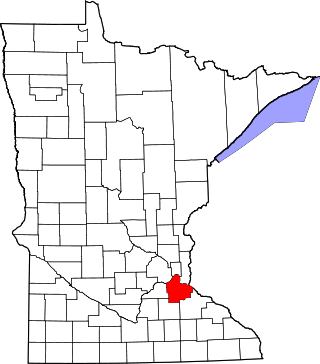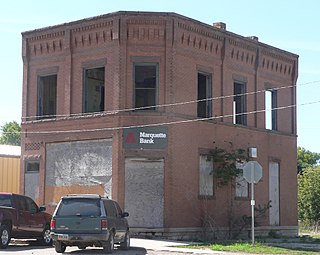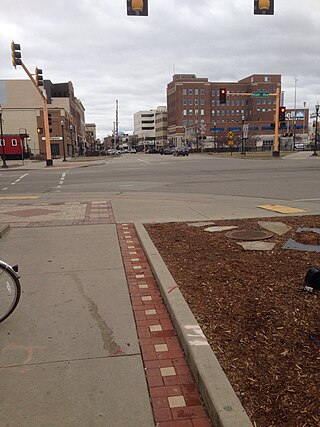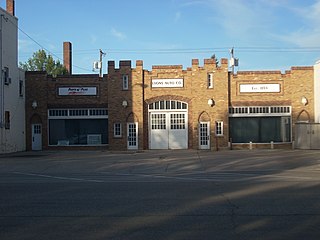
This is a list of the National Register of Historic Places listings in Dakota County, Minnesota. It is intended to be a complete list of the properties and districts on the National Register of Historic Places in Dakota County, Minnesota, United States. Dakota County is located in the southeastern part of the U.S. state of Minnesota, bounded on the northeast side by the Upper Mississippi River and on the northwest by the Minnesota River. The locations of National Register properties and districts for which the latitude and longitude coordinates are included below, may be seen in an online map.

This is a list of the National Register of Historic Places listings in Charles Mix County, South Dakota.

The First State Bank Building in Revillo, South Dakota was built in 1905. It was listed on the National Register of Historic Places in 1987.

Cass County Court House, Jail, and Sheriff's House is a property in Fargo, North Dakota that was listed on the National Register of Historic Places in 1983.

Downtown Fargo District, or Downtown Fargo Historic District, is a historic district in Fargo, North Dakota that was listed on the National Register of Historic Places in 1983.

North Dakota State University District is a 36-acre (15 ha) historic district on the campus of North Dakota State University, in Fargo, North Dakota, that was listed on the National Register of Historic Places in 1986.

The University of North Dakota Historic District is a 127-acre (51 ha) area in Grand Forks, North Dakota that was listed as a historic district in the National Register of Historic Places on January 13, 2010.

Lyons Garage was a building in Grand Forks, North Dakota that was built in 1929 and was listed on the National Register of Historic Places in 1982. The rectangular building was built as an expansion of an adjacent Lyons Auto Supply company building that had been built in 1912. The 1912 building was not included in the National Register listing.

Dinnie Apartments is a building in Grand Forks, North Dakota, United States. It was listed on the National Register of Historic Places (NRHP) in 1994. Dinnie Apartments is included in the Grand Forks Near Southside Historic District, which was listed on the NRHP in 2004.

The First National Bank is a five-story building in Grand Forks, North Dakota, that was built in 1914–15 and listed on the National Register of Historic Places in 1982. It was built for the Scandinavian-American Bank, but has been identified as the First National Bank building since 1929.

Grand Forks station is a property in Grand Forks, North Dakota, United States, that was listed on the National Register of Historic Places in 1982 as the Northern Pacific Depot and Freight House. It was used both as a passenger station and a freight warehouse/depot by the Northern Pacific Railway.

The State Bank of Antler, also known as the Antler Square Building, is a historic building in Antler, North Dakota, located in the center of the town's public square.
Ipswich Baptist Church is a historic church at Main Street and 3rd Avenue in Ipswich, South Dakota, USA, that includes Gothic Revival architecture. It was built in 1924.

The Evans Block, also known as Northwestern National Bank Building, is a historic building located in Sioux City, Iowa, United States. The city experienced a building boom that began in the late 1880s and continued into the early 1890s. Fred T. Evans, an entrepreneur who had business interests in Iowa, Nebraska and South Dakota, had this building constructed to house Northwestern National Bank of which he was the president. The bank occupied the main level and other offices were housed on the upper floors. Local architect Charles P. Brown designed the four-story Romanesque Revival style building. The Black Hills sandstone for the public facades was from Evans' quarry. The Panic of 1893 brought Sioux City's building boom to an end, and the Evans block was sold in January 1895. Subsequently, the building has housed a hotel, a factory, a saloon, and a variety of stores. It was individually listed on the National Register of Historic Places in 1985, and as a contributing property in the Fourth Street Historic District in 1995.
The Marcus P. Beebe Library, located at Main St. and 2nd Ave. in Ipswich, South Dakota, was built in 1930–1931. It is also known as the Ipswich Public Library. It was listed on the National Register of Historic Places in 1977.

The First National Bank of Norden, at 503 Main Av. in Lake Norden, South Dakota, was built in 1920. It was listed on the National Register of Historic Places in 2005.
The First National Bank in Gary, South Dakota is a building on South Dakota Highway 22 which was built in 1917. It was listed on the National Register of Historic Places in 1977.

The Western Union Building, formerly known as the Hagerty Block and currently as the Dacotah Prairie Museum, is a historic bank building in Aberdeen, South Dakota. It is individually listed on the National Register of Historic Places and is a contributing property to the Aberdeen Commercial Historic District.

The Wakonda State Bank, later the Wakonda Public Library, is a historic bank building at 118 Ohio Street in Wakonda, South Dakota. It was listed on the National Register of Historic Places in 2003 due to being a rare surviving local example of early 20th-century architecture.




















